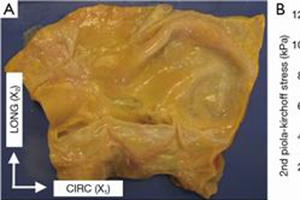Biomechanical properties of the thoracic aorta in Marfan patients
Abstract
Background: Marfan syndrome (MFS), a genetic disorder of the connective tissue, has been strongly linked to dilation of the thoracic aorta, among other cardiovascular complications. As a result, MFS patients frequently suffer from aortic dissection and rupture, contributing to the high rate of mortality and morbidity among MFS patients. Despite the significant effort devoted to the investigation of mechanical and structural properties of aneurysmal tissue, studies on Marfan aneurysmal biomechanics are scarce. Ex vivo mechanical characterization of MFS aneurysmal tissue can provide a better insight into tissue strength outside the physiologic loading range and serve as a basis for improved risk assessment and failure prediction.
Methods: The mechanical and microstructural properties of MFS aneurysmal thoracic aorta (MFS, n=15, 39.5±3.91 years), non-MFS aneurysmal thoracic aorta (TAA, n=8, 52.8±4.9 years), healthy human thoracic aorta (HH, n=8, 75.4±6.1 years), and porcine thoracic aorta (n=10) are investigated. Planar biaxial tensile testing and uniaxial failure testing were utilized to characterize the mechanical and failure properties of the tissue, respectively. Verhoeff-Van Gieson (VVG) and PicroSirius Red stains were utilized to visualize the elastin and collagen fiber architecture, respectively.
Results: MFS tissue was found to have age-dependent but diameter-independent mechanical, structural, and morphological properties, also showing extensive elastin fiber degradation. Non-MFS thoracic aneurysmal aorta was thicker and stiffer than age-matched MFS tissue. Moreover, non-MFS thoracic aneurysmal mechanics resembled closely the mechanics of older healthy human tissue. Younger MFS tissue (<40 years) exhibited similar mechanical and structural properties to aged porcine tissue.
Conclusions: Both age and aneurysmal presence were found to be factors associated with increased stiffness in aortic tissue, and aortic diameter was not a significant determinant of mechanical property deterioration. Additionally, the presence of MFS was found to induce stiffening of the thoracic aorta, although not to the extent of the non-MFS aneurysm.
Cover






